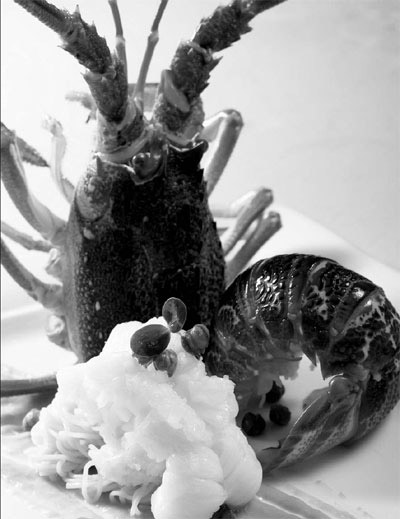
 |
|
Leek with lobster at Herbal Cuisine Kithchen is a kind of warming food recommended for spring. Provided to China Daily |

The sap is running and the shoots are sprouting. Spring is definitely in the air, and in the kitchens. Ye Jun in Beijing gives us a preview of the new season's menus.
Seasonal greens, mushrooms and sprouts are beginning to appear in home kitchens and restaurant tables, and China's regional-cuisine restaurants, especially, are making the best of the produce of spring.
After a cold, dry winter, the body needs to detoxify, and "nourish and warm up", according to Wang Yunzhang, chef of Herbal Cuisine Kitchen. He uses Chinese herbs and nutritional foods at his restaurant to help the body get healthy and reach internal balance.
According to traditional Chinese medicine, spring is the time when the liver has the strongest energy among internal organs. Therefore it is the time to ease excessive "fire" in the liver and replenish energy in the stomach and spleen, Wang says.
"Spring and summer are seasons to clear harmful elements out of the body, while autumn and winter are when you store energy back. That's how the body balances itself," says the chef.
Most green vegetables can help clear the liver. Wang recommends kale, indigowoad leaf or banlan gen, dandelion, little tender Chinese cabbage, celery and arugula.
In the five elements of metal, wood, water, fire and earth, the liver is the "wood", and the spleen the "earth" among internal organs.
When wood grows too strong, the earth needs replenishing. Wang Yunzhang also suggests eating yellow food such as carrot, pumpkin and gingko seeds to help the spleen and stomach.
Following the same theory, one should eat sweet-tasting food that will nourish the "earth" and avoid acid food.
"Spring is a time to grow. Therefore it will be helpful to eat foods that grow upward, such as sprouts," says Wang.
That includes the shoots from beans, willow, fragrant Chinese toon, leek and Chinese prickly ash or Sichuan peppercorn.
Mushrooms are for all seasons. They are known for their anti-carcinogenic properties, and they help boost immunity. Wang says that is especially needed in spring, when temperature difference between day and night makes greater demands on the body.
In the Chinese yin and yang theory, spring is when the stronger male element rises, so it is the time to eat warming foods.
Chef Wang says chicken broth and lamb soup are warming, as are green onions with shrimp or lobster.
Jiang Jian, executive chef at Chynna Chinese Restaurant, says people need heavier food and seasoning in winter, but when spring comes, palates lighten.
In that spirit, Chynna's spring menu offers fresh asparagus and boletus mushrooms, as well as Chinese yam, which is good for the lungs, and Job's tears, a tropical grain which is said to help detoxify the body.
For meat, the restaurant makes a stewed fish head with American ginseng. The huge fish head, weighing about 2.5 kilograms, comes from Qiandao Lake in Hangzhou and is supposed to nourish spleen and stomach.
"Spring is a good time for fresh fish, because they are near spawning," says Jiang. "The fish accumulates more nutrients, and contains more of various amino acids."
Keli Huaiyang Cun, serving Huaiyang cuisine, also offers some of the country's most delicious fishes in demand. Knife fish, reeves shad and long-nose catfish are now in season.
While knife fish and shad are particularly costly before Qingming Festival (April 4), long-nose catfish is more affordable and can be made into a tasty white broth.
The silver fish from Suzhou Taihu Lake is less than 10 centimeters long, and also in season.
For vegetables, Zhang Guangjun, the executive chef at Huaiyang Cun, recommends the spring bamboo shoots from Zhejiang. The restaurant makes them into a cold appetizer, or a quick-fry with oil and soy sauce as a flavorful hot dish.
Another popular herald of spring is the Chinese toon tree sprouts, most popularly served with bean curd. The fragrant shoots are macerated with salt, chopped and served with mashed tofu.
They are also served in omelets in many Chinese homes. The toon sprouts are available in the market and will last until the end of summer.
From farther afield, regional ingredients are being brought into the cities to temp diners. Pucai, the tender hearts of a water reed from Huai'an of Jiangsu province, is a prized delicacy with a corresponding price tag. It is often served steamed in chicken broth, and scattered with dried shrimps. Some say pucai tastes better than white asparagus.
Spring is the season when Yunnan produces plenty of flowers, some of which end up on the dinner table. At Xisi Batiao, a restaurant which fuses Beijing and Yunnan cuisine, Chef Zhang Jinya is serving up a jasmine omelet, He also makes a chilled salad of assorted mint leaves, and sauts tender towel gourd sprouts, which are now at their best.
And after a hard winter's curing, the latest ham and preserved pork from the Yunnan area also ready for the table, and Zhang says he fries ham slices with fresh spring bamboo shoots and tender slices of Yunnan green bell pepper.
The spring banquet, as you can see, is just beginning.